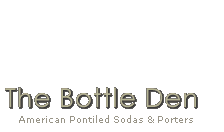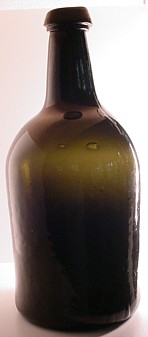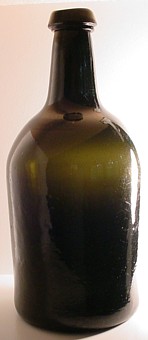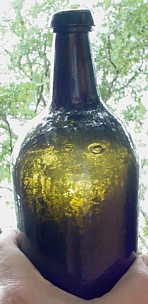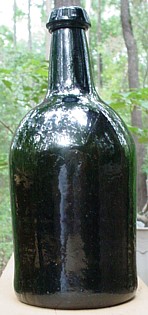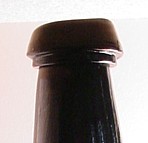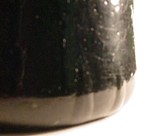Early Maryland Black Glass...
Article V - Black Glass Ales of 1780-1820 | back to Articles
by Wil Martindale
Upon recently acquiring an early black glass quart porter or ale, which I believed to be a Baltimore item, I decided to look further into some assumptions regarding glass manufacture from that locale during the period of its manufacture, circa 1780 - 1820.
This article explains how I came to attribute the bottle's age and provenance, and what else I uncovered regarding the area, the period, and the historical evidence that helps guide that attribution. But before getting into specifics, I'd like to establish the fact that porter and ale was regularly being bottled during this period in Baltimore, as opposed to being sold primarily from casks or barrels, as some writers in the past have suggested.
While scanning Baltimore's American and Commercial Daily Advertiser for 1804, I stumbled upon an ad from early Baltimore brewer and bottler John Readel, pertaining to the relocation of his long established bottling cellar:
 Ad from 1804 Baltimore Newspaper: American and Commercial Daily Advertiser
Ad from 1804 Baltimore Newspaper: American and Commercial Daily Advertiser
Readel was still bottling porter, ale and cider in Baltimore as late as 1829, but in this early ad for PHILADELPHIA PORTER & ALE, he states that he "now keeps his bottling cellar and porter vaults in North Gay Street", after being long since established in the city, "and as usual, at Fell's Point, under Peck's coffee house (which is convenient for shipping)."
Apparently, Readel's porter bottling cellars were operating in Baltimore even well before 1804 both in the City and at Fell's Point.
Another 1805 ad for BOTTLED PORTER ALE & CIDER (both foreign and domestic) mentions a bottling cellar at 96 North Howard Street, with a front cellar "fitted up" to accommodate the public, who may, after an afternoon walk to the park, be pleasingly refreshed with a wholesome beverage.
A later, June 1810 issue of the Baltimore Whig features an ad from brewer Marcus McCausland, who "Offers for sale a large stock of prime Porter and Ale both in Wood and Bottles" citing that "Bottles not returned during the Bottling season will be charged at an advanced price."
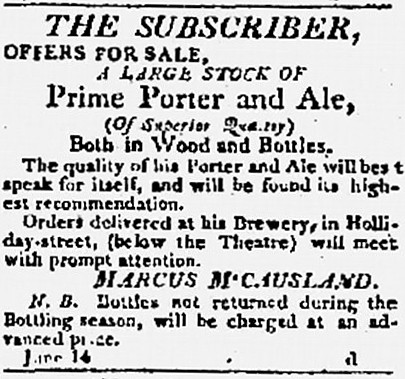
Ad from an 1810 Baltimore Whig Newspaper
These advertisements are representative of a substantial brewing and bottling trade for 'Porter, Ale & Cider' in the City of Baltimore during the manufacture and use of this bottle. One of these proprietors may have handled the bottle pictured to your right at some point in time. In fact, it is quite likely.
DATING & PROVENANCE
The sand pontil, form, density of color and transitional lip treatment are the most definitive characteristics in dating this bottle. In the 1980's, I had acquired a similar black glass bottle in an antique shop in Laurel, Md. It was free blown or form molded, but in a taller, more narrow rum or ale shape.
It featured the exact same sand pontil and crude lip treatment, with an uneven, slightly flared short to medium height taper over a very short, flat band. My description cannot do a visual comparison justice, however, suffice it to say that my recollection of that bottle's lip and this bottle's lip were that they were a matching pair of two, out of hundreds of black glass lips seen over the years.
Then there are the mold marks at the edge of the base. At least 2 experienced diggers have heard of these mold marks as being an attribute of a "Baltimore made" bottle (with at least one having dug more than one example). Another interesting example of these marks is found on the bottle sold by Dale Murschell at the York 2008 National show.
I questioned Dale regarding this bottle and he seemed quite certain that the marks are a tell tale sign of a Baltimore product, but he did not elaborate on how he came to that conclusion. The bottle was subsequently purchased by the Noordsy's and sold from their website, where an image of the bottle and a description of their attribution, acknowledging Dale's opinion can be found here.
Interestingly, while the vertical mold marks are not shown in the image, they are as I recollect, identical to the bottle here. The lip treatment of Dale's example, while looking American, does not look distinctly "Baltimore" in execution. It could easily pass for a New England or New York style lip finish. It also looks later than 1808, as the inlaid seal suggests, however that date could be of some earlier significance to "S. Jones" than the manufacture of the bottle. I do believe however, that both bottles were blown in the same dip mold, and I suspect my example is a bit earlier.
Finally, we have the location of the bottle's excavation.This particular bottle was dug in the mid 1990's from an oval brickliner off East Street, in the Oldtown / Jonestown area of Baltimore, and was the only intact bottle in the privy except for an early unembossed London mustard type bottle.
When taking into consideration the context of the dig, provenance, pontil, lip treatment, mold markings, background data and other factors, all indications point to a bottle manufactured between 1780 and 1820 for the Baltimore market, where it ultimately was discarded. I am leaning toward 1800-1810 to be more specific.
But was the bottle manufactured in Baltimore? At the Baltimore Glass Works? Evidence suggests that it could have been, but not necessarily.
In fact, there were at least two other Glass Manufactories in Maryland which manufactured quart bottles for the Baltimore market between 1800-1810. And if by chance the Bottle does pre-date 1800, it is quite likely the product of one of them.
2012 postscript: I have since seen another example of this exact same bottle from a Lutherville, Md. ebay seller who had 2 other ealy Baltimore made black glass bottles, as well another dip mold quart of Maryland, or possibly English, manufacture. There still exists the possibility that the quart which is the focus of this article was manufactured in England for the Baltimore market. But with certainty we know that at least a half dozen whole examples of this dip mold were in use in Baltimore during the period of their manufacture.
